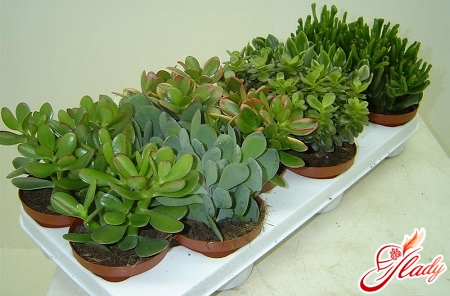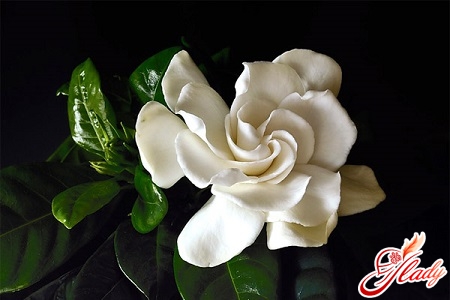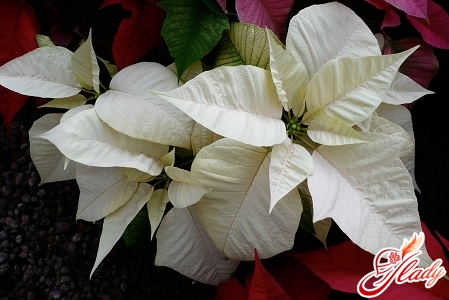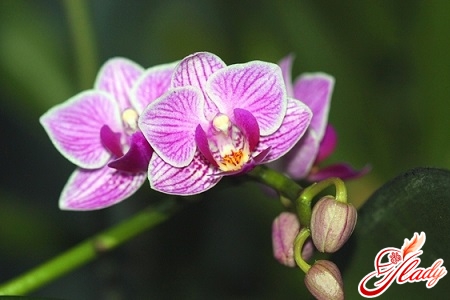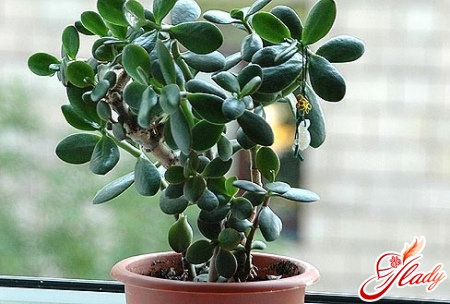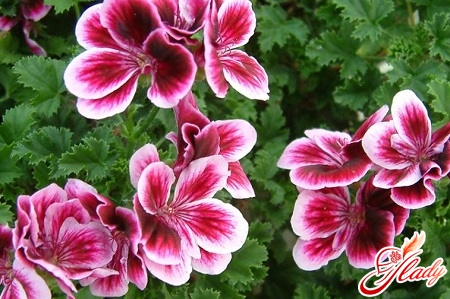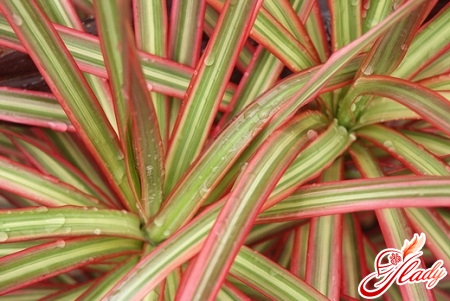
Dracaena Marginata, or fringed, isone of the most common species of the whole family of asparagus. Homeland dracenas are tropical forests and savannahs of Africa and South Asia. And she won her popularity thanks to such qualities as unpretentiousness, minimal care and simple reproduction. Most often in Europe this tree is used as a decorative indoor flower. Although, if you place the dracenu on the street, the dracene Marginata perfectly adapts to the local climate. The only condition for active growth: the ambient temperature should not be below eighteen degrees. Dracaena Marginata grows slowly, but reaches for a period of life up to three meters in height and even more. The leaves of the tree are bordered with a contrasting red color and can grow up to 50-70 cm in length. There is a kind of dracaena with a two-colored border: first the sheet is outlined with a red edging, and then yellow - the gilt effect of such a dracaena is very impressive. High copies of dracaena look good in office spaces and spacious halls, and small "shaggy tails" easily fit into any apartment interior. In addition to decorative advantages, the dracaena bordered is a kind of humidifier and air purifier. The plant absorbs formaldehyde and trichlorethylene, which is the product of the disintegration of the powder used in laser printers and photocopiers. You will be interested to learn that, according to the teachings of Feng Shui, Dracaena Marginata will inspire you to exploit, help fight against laziness and pessimism. Ancient Greek translation of it means "female dragon", or there is another version - "dragon tree". The bark of the bared trunk really resembles the skin of a dragon, the effect is associated with the formation on the trunk of secondary tissue from extinct leaves.
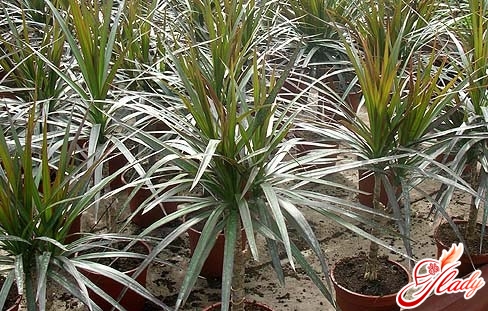
Content Recommendations
So, despite the unpretentiousness of the dracaenaMarginta, it is worthwhile to dwell on the main recommended for her conditions of detention. What do they need to know? First of all, to prevent a number of diseases that adversely affect the external characteristics of the plant. In addition, illiterate care is the main cause of death of the tree and contamination of all flowers in the house. Lighting Dracaena Marginata is a lover of diffuse light, and, like all leafy plants, she is afraid of direct sunlight. The variegated species of dracaena prefer intensive lighting, rather than dark green specimens. When there is a lack of lighting, the leaves begin to lose their color, and sun burns leave yellow spots on the leaves, which gradually expand and dry them. The best place in the apartment for dracaena - opposite the window in the back of the room; In addition, the dracene Marginata "does not disdain" and artificial lighting. In the summer, you can put the dracene on the balcony or the garden, without forgetting to choose a shaded place. Care in the winter period differs only by the addition of additional lighting, for example, a conventional light bulb. Temperature What is significant in the favorable content of dracaena, is the temperature regime. Dracaena Marginata is a thermophilic plant, and therefore it is worth taking care that in winter the temperature does not drop below sixteen degrees of heat. But to the upper threshold of temperature the plant adapts much better, and it does not have special significance for growth. Therefore, in the summer, care for the plant and at all elementary: put a pot of dracaena on a shaded balcony, sprinkle more often and water on time. Humidity Moisture is another important factor in healthy plant growth. Dracaena fringed with ease adapts to dry air in the apartment. The main sign of insufficient moisture is external signs - dry tips of leaves. In this case, you need to increase the intensity of spraying or put the pot on a special pallet with wet claydite. Dry leaves need to be cut, but in no case do not cut off the living tissue of the leaves. You probably know how destructive for any plant heating batteries. The most common cause of death of most leaves is the hot dry air emanating from them. To avoid negative consequences, it is strongly recommended not to put a pot of flowers next to the radiators. And one more recommendation - arrange your favorite water procedures. Place the pot under a shallow shower, pre-covering the ground with cellophane. With this simple trick you will ease the care of the leaves and prevent the appearance of small pests. Watering There is nothing easier than watering a dracaena: watering should be frequent and moderate, and the soil is always slightly moistened. Sometimes, once a month, you can let the ground dries to a depth of three or four fingers. For the dracaena, excess moisture is more pernicious than the short-lived dryness of the soil. In the case of the formation of a white salt deposit on the surface of the soil, you need to replace the top layer of the substrate with fresh ones and loosen the soil more often. In winter, the frequency and volume of watering is reduced, spraying at room temperature below + 15 ° C is stopped altogether. Top-dressing Dracena Marginata is recommended to fertilize almost the whole year. In spring and summer, when the plant leaves grow actively, it is necessary to feed twice a month, in winter, during the rest period, it is necessary to reduce fertilizer volume by half and make the composition no more than once a month. And if the temperature of the plant is below +18 - + 20 ° C, then it is not recommended to feed the dracenium. As a fertilizer, it is best to use ready-made compounds designed specifically for palm trees and dracen. Add the nutrient mixture in dilute form to the freshly moistened soil. Transplantation Young plants can be transplanted annually into a pot larger in volume by two fingers. Adult shoots are transplanted in spring every two to three years by the method of transshipment: do not injure the fragile root system. The large dracenes contained in tubs are not transplanted, but only replace the top layer of soil with fresh ones. The substrate is best purchased ready, special - for transplanting palms and dracen. It is not superfluous to add to the soil a brick crumb for looseness and charcoal to prevent diseases of the root system. When transplanting the dracena Marginata, pay special attention to quality drainage. As already mentioned above, the plant does not tolerate excess water in the soil. Caring for transplanted dracaena should be done in a similar way, reducing for a while fertilizing. Reproduction Reproduction of the dracaena is not very complex and is considered to be fairly unsophisticated. The simplest way to reproduce the dracaena is cuttings. To do this, the upper part of the stem is cut off and, after shearing treatment, the composition for stimulation of the root growth is placed in a container with water or in a traditional substrate. Be sure to cover the shank with a hood or place it in a mini-greenhouse. Do not forget to ventilate it regularly and moisten the soil. Within a month, the first roots will appear, and then it will be possible to transplant the process into the necessary pot. Further care for the plant provides for compliance with all of these recommendations. Another variant of reproduction is stem cuttings. It differs in that the cuttings are not tops, but part of the stem. Thus, you can get several shoots at once for breeding. Sliced cuttings need to be dried a little and stuck in the necessary earth mixture. The formation of lateral shoots on the cuttings will indicate the development of the root system. It is important to remember that when multiplying in any way for successful root growth, it is necessary to increase the temperature in the mini-greenhouse and periodically ventilate the air. Diseases and pests Fortunately, the dracene Marginata, or fringed, does not belong to the number of often diseased houseplants. In general, such pests as a scabbard, thrips and spider mite can attack a plant. At the initial stage the dracene can be cured in an elementary way, treating the leaves with a soap solution. For the affected plant, scrupulous care is required, which consists in daily processing; pay special attention to the inside of the leaves. In case of neglected cases, you will have to use chemical insecticides. Avoid pest attack, regular preventive maintenance will help you: spraying with Bordeaux liquid, weekly shower and regular external examination. 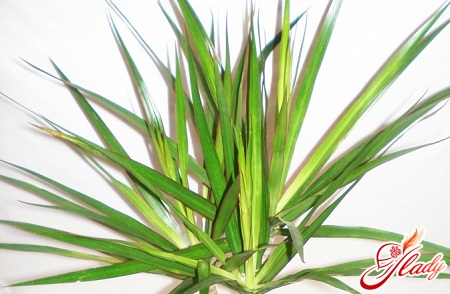
Let's sum up the results
So, such a sign as yellowing and falling offthe lower leaves, the phenomenon is natural and should not bother you. As a rule, leaves die due to their old age every two years. Continue to care for the plant in the usual way for you, and if you are deeply concerned about the lower dry leaves, update the dracenium by applying multiplication with air layers. Dry edges and ends of leaves indicate insufficient air humidity. With such signs, treatment will consist in increasing moisture by additional spraying and increasing the number of water procedures. If you notice that the leaves become soft and twist at the same time, then this is a clear sign of dracaenic hypothermia. You need to raise the temperature of the plant, but do not put a pot next to the batteries for this. The formation of brown spots on the leaves indicates a lack of water. Increase the amount and frequency of Drazen watering. But the pallor on the leaves is nothing but sunburn. Remove the plant pot from the window sill or shade the window. Here, perhaps, and all the recommendations for the content of Dracaena Marginata. Agree, caring for her is not at all more difficult than for ordinary room flowers, and there is always the opportunity to avoid unnecessary problems, giving a minimum of time for prevention. Surely many of you already have the experience of floriculture and you know how to take care of Dragan's Marginata, so we will gladly supplement the article with your recommendations. Finally, we want to say only one thing: without care and love even the centenary bamboo will wither!




